Effects of High Al Content on the Phase Constituents and Thermal Properties in NiCoCrAlY Alloys
Abstract
:1. Introduction
2. Experiments
2.1. Sample Preparations
2.2. Microstructure Characterizations
2.3. Phase Equilibria Calculations
2.4. Thermophysical Analysis
3. Results
3.1. Phase Equilibria Calculations
3.2. HE-XRD Results
3.3. Microstructures of As-Cast Alloys
3.4. Microstructures of Quenched Alloys
3.5. Thermal Properties
4. Discussion
4.1. Phase Constituents
4.2. Solidification Behaviors
4.3. Thermal Expansion Behaviors
5. Conclusions
- The phase constituents of as-cast 12Al, 16Al, and 20Al alloys are determined to be β + γ + γ′ + σ + Ni5Y, β + σ + Ni5Y, and β + α + Ni5Y, respectively, which are verified by the HE-XRD and electron microscopy analyses with the assistance of thermodynamic equilibrium calculations. The β phase is the primary solid phase in NiCoCrAlY alloys. High Al content improves the stability of the β, σ, and α phases.
- The solidification temperature ranges are widened with an increase in Al content. Thus, an evolution of the as-cast microstructure morphology from a dendrite structure to an equiaxed grain structure is observed. Based on the experimental results and phase equilibria calculations, schematic diagrams of the liquid-to-solid and solid-to-solid phase transitions in the casting process are illustrated.
- The coefficient of thermal expansion is analyzed. It is closely related to the phase constituents and solid-to-solid phase transitions at elevated temperatures.
Author Contributions
Funding
Institutional Review Board Statement
Informed Consent Statement
Data Availability Statement
Conflicts of Interest
References
- Gudivada, G.; Pandey, A.K. Recent developments in nickel-based superalloys for gas turbine applications: Review. J. Alloys Compd. 2023, 963, 171128. [Google Scholar] [CrossRef]
- Prabhakaran, D.; Jegadeeswaran, N.; Somasundaram, B.; Raju, B.S. Corrosion resistance by HVOF coating on gas turbine materials of cobalt based superalloy. Mater. Today Proc. 2020, 20, 173–176. [Google Scholar] [CrossRef]
- Thakare, J.G.; Pandey, C.; Mahapatra, M.M.; Mulik, R.S. Thermal Barrier Coatings—A State of the Art Review. Met. Mater. Int. 2020, 27, 1947–1968. [Google Scholar] [CrossRef]
- Ghadami, F.; Sabour Rouh Aghdam, A.; Ghadami, S. Microstructural characteristics and oxidation behavior of the modified MCrAlX coatings: A critical review. Vacuum 2021, 185, 109980. [Google Scholar] [CrossRef]
- Jackson, G.A.; Sun, W.; McCartney, D.G. The influence of microstructure on the ductile to brittle transition and fracture behaviour of HVOF NiCoCrAlY coatings determined via small punch tensile testing. Mater. Sci. Eng. A 2019, 754, 479–490. [Google Scholar] [CrossRef]
- Lim, L.Y.; Meguid, S.A. Temperature dependent dynamic growth of thermally grown oxide in thermal barrier coatings. Mater. Des. 2019, 164, 107543. [Google Scholar] [CrossRef]
- Zhao, W.H.; Wang, S.B.; Li, L.A.; Liu, D.L.; Li, C.W.; Wang, Z.Y. Characterizing the thermally grown oxide in thermal barrier coating by terahertz time domain spectroscopy. Coatings 2023, 13, 376. [Google Scholar] [CrossRef]
- Shi, D.Q.; Song, J.A.; Qi, H.Y.; Li, S.L.; Yang, X.G. Effect of interface diffusion on low-cycle fatigue behaviors of MCrAlY coated single crystal superalloys. Int. J. Fatigue 2020, 137, 105660. [Google Scholar] [CrossRef]
- Chen, Y.; Zhao, X.; Xiao, P. Effect of microstructure on early oxidation of MCrAlY coatings. Acta Mater. 2018, 159, 150–162. [Google Scholar] [CrossRef]
- Meng, G.; Liu, H.; Liu, M.; Xu, T.; Yang, G.; Li, C.; Li, C. Large-grain α-Al2O3 enabling ultra-high oxidation-resistant MCrAlY bond coats by surface pre-agglomeration treatment. Corros. Sci. 2020, 163, 108275. [Google Scholar] [CrossRef]
- Salam, S.; Hou, P.Y.; Zhang, Y.D.; Wang, H.F.; Zhang, C.; Yang, Z.G. Compositional effects on the high-temperature oxidation lifetime of MCrAlY type coating alloys. Corros. Sci. 2015, 95, 143–151. [Google Scholar] [CrossRef]
- Pereira, J.C.; Zambrano, J.C.; Rayón, E.; Yañez, A.; Amigó, V. Mechanical and microstructural characterization of MCrAlY coatings produced by laser cladding: The influence of the Ni, Co and Al content. Surf. Coat. Technol. 2018, 338, 22–31. [Google Scholar] [CrossRef]
- Texier, D.; Ecochard, M.; Gheno, T.; Monceau, D.; Salem, M.; Lours, P. Screening for Al2O3 failure in MCrAlY APS coatings using short-term oxidation at high temperature. Corros. Sci. 2021, 184, 109334. [Google Scholar] [CrossRef]
- Zhang, P.M.; Yuan, K.; Peng, R.L.; Li, X.H.; Johansson, S. Long-term oxidation of MCrAlY coatings at 1000 °C and an Al-activity based coating life criterion. Surf. Coat. Technol. 2017, 332, 12–21. [Google Scholar] [CrossRef]
- Liu, T.; Zhang, D.; Wang, Z.; Xiang, L.; Zhao, Y.; Hu, S.; Huang, B.; Xie, Z. Enhanced structural stability and oxidation resistance of NiCoCrAlY bonding layer via Al addition. Vacuum 2023, 207, 111543. [Google Scholar] [CrossRef]
- Dong, S.Z.; Li, Y.K.; Xu, M.M.; Li, S.; Dong, Z.H.; Bao, Z.B.; Zhu, S.L.; Wang, F.H. Effect of Re-base diffusion barrier on the oxidation performance of a gradient NiCoCrAlY coating. Surf. Coat. Technol. 2023, 452, 129105. [Google Scholar] [CrossRef]
- Liang, J.J.; Wei, H.; Zhu, Y.L.; Sun, X.F.; Hu, Z.Q.; Dargusch, M.S.; Yao, X.D. Influence of Re on the properties of a NiCoCrAlY coating alloy. J. Mater. Sci. Technol. 2011, 27, 408–414. [Google Scholar] [CrossRef]
- Schab, J.C.; Zimmermann, J.R.A.; Grasso, P.D.; Stankowski, A.; Heinze, S.; Marquardt, A.; Leyens, C. Thermodynamic calculation and experimental analysis of critical phase transformations in HVOF-sprayed NiCrAlY-coating alloys. Surf. Coat. Technol. 2019, 357, 924–938. [Google Scholar] [CrossRef]
- Yang, S.; Yang, L.; Chen, M.; Wang, J.; Zhu, S.; Wang, F. Understanding of failure mechanisms of the oxide scales formed on nanocrystalline coatings with different Al content during cyclic oxidation. Acta Mater. 2021, 205, 116576. [Google Scholar] [CrossRef]
- Pillai, R.; Chyrkin, A.; Quadakkers, W.J. Modeling in high temperature corrosion: A review and outlook. Oxid. Met. 2021, 96, 385–436. [Google Scholar] [CrossRef]
- Chen, H.; Li, Z.; Li, L.; Guo, H.; Rushworth, A.; Wang, X. Microstructure evolution of as-cast CoNiCrAl bond coat alloys after isothermal heat treatments. Mater. Charact. 2023, 204, 113183. [Google Scholar] [CrossRef]
- Wu, Y.; Li, Y.T.; Xu, Y.T.; Kang, M.D.; Wang, J.; Sun, B.D. Unveiling the mechanism of yttrium-related microstructure inhibiting or promoting high-temperature oxidation based on Ni-Al-Y alloys. Acta Mater. 2021, 211, 116879. [Google Scholar] [CrossRef]
- Liu, Y.Z.; Li, Z.; Yu, W.; Ma, D.P.; Guo, Y.T.; Wang, Q. Phase Equilibria of the Ni-Al-Cr-Y quaternary system and the Ni-Al-Y ternary system at 900 °C. J. Phase Equilibria Diffus. 2023, 44, 575–593. [Google Scholar] [CrossRef]
- Dupin, N.; Sundman, B. A thermodynamic database for Ni-base superalloys. Scand. J. Metall. 2001, 30, 184–192. [Google Scholar] [CrossRef]
- TCS Ni-Based Superalloys Database (TCNI10). Developed and Provided by Thermo-Calc Software 2023a. Available online: www.thermocalc.com (accessed on 11 August 2023).
- Gale, W.F.; King, J.E. Precipitation of chromium containing phases in aluminide coated nickel-base superalloy single crystals. J. Mater. Sci. 1993, 28, 4347–4354. [Google Scholar] [CrossRef]
- Haynes, J.A.; Pint, B.A.; Porter, W.D.; Wright, I.G. Comparison of thermal expansion and oxidation behavior of various high-temperature coating materials and superalloys. High Temp. Technol. 2014, 21, 87–94. [Google Scholar] [CrossRef]
- Zhang, Z.; Li, M.; Cavin, J.; Flores, K.; Mishra, R. A fast and robust method for predicting the phase stability of refractory complex concentrated alloys using pairwise mixing enthalpy. Acta Mater. 2022, 241, 118389. [Google Scholar] [CrossRef]
- Guo, S. Phase selection rules for cast high entropy alloys: An overview. Mater. Sci. Technol. 2015, 31, 1223–1230. [Google Scholar] [CrossRef]
- Takeuchi, A.; Inoue, A. Classification of bulk metallic glasses by atomic size difference, heat of mixing and period of constituent elements and its application to characterization of the main alloying element. Mater. Trans. 2005, 46, 2817–2829. [Google Scholar] [CrossRef]
- Shivam, V.; Kar, S.; Mandal, G.K.; Srivastava, V.C. Microstructural evolution and phase selection during solidification of AlCrCuFeNi high entropy alloy. J. Alloys Compd. 2023, 963, 171261. [Google Scholar] [CrossRef]
- Noebe, R.D.; Bowman, R.R.; Nathal, M.V. Physical and mechanical properties of the B2 compound NiAl. Int. Mater. Rev. 1993, 38, 193–232. [Google Scholar] [CrossRef]
- Hajra, R.N.; Tripathy, H.P.; Rai, A.K.; Vijayashanthi, N.; Raju, S.; Saroja, S. Study of high temperature phase stability and phase transformation kinetics of sigma and parent alpha phase in Fe55Cr45 (wt. %) alloy. J. Alloys Compd. 2017, 727, 940–947. [Google Scholar] [CrossRef]
- Yu, L.; Ye, X.; Fang, D.; Liu, M.; Guo, H.; Wang, S.; Zhao, G.; Li, B.; Wu, H. Precise design strategy of FeNiCrMo eutectic high-entropy alloys. J. Mater. Res. Technol. 2022, 21, 3207–3219. [Google Scholar] [CrossRef]
- Young, G.A.; Hackett, M.J.; Tucker, J.D.; Capobianco, T.E. 3.15—Welds for Nuclear Systems. In Comprehensive Nuclear Materials, 2nd ed.; Konings, R.J.M., Stoller, R.E., Eds.; Elsevier: Oxford, UK, 2020; pp. 517–544. [Google Scholar]
- Taylor, T.A.; Walsh, P.N. Thermal expansion of MCrAlY alloys. Surf. Coat. Technol. 2004, 177–178, 24–31. [Google Scholar] [CrossRef]
- Taylor, T.A.; Walsh, P.N. Dilatometer studies of NiCrAlY coatings. Surf. Coat. Technol. 2004, 188–189, 41–48. [Google Scholar] [CrossRef]
- Chen, H.; Li, L.; Yang, R.; Zhu, W.; Rushworth, A.; Yin, Y.; Wang, X. Microstructure and thermophysical properties of as-cast CoNiCrAl bond coat alloys at different Al contents. J. Alloys Compd. 2022, 918, 165575. [Google Scholar] [CrossRef]
- Hernández-Acosta, M.A.; Martines-Arano, H.; Soto-Ruvalcaba, L.; Martínez-González, C.L.; Martínez-Gutiérrez, H.; Torres-Torres, C. Fractional thermal transport and twisted light induced by an optical two-wave mixing in single-wall carbon nanotubes. Int. J. Therm. Sci. 2020, 147, 106136. [Google Scholar] [CrossRef]
- Tang, Y.C.; Li, W.; Li, C.L.; Lu, S.; Vitos, L.; Pyczak, F. First-principles calculations of elastic and thermodynamic properties for multi-component Co-based superalloys. Metall. Mater. Trans. A 2023, 54, 1635–1648. [Google Scholar] [CrossRef]




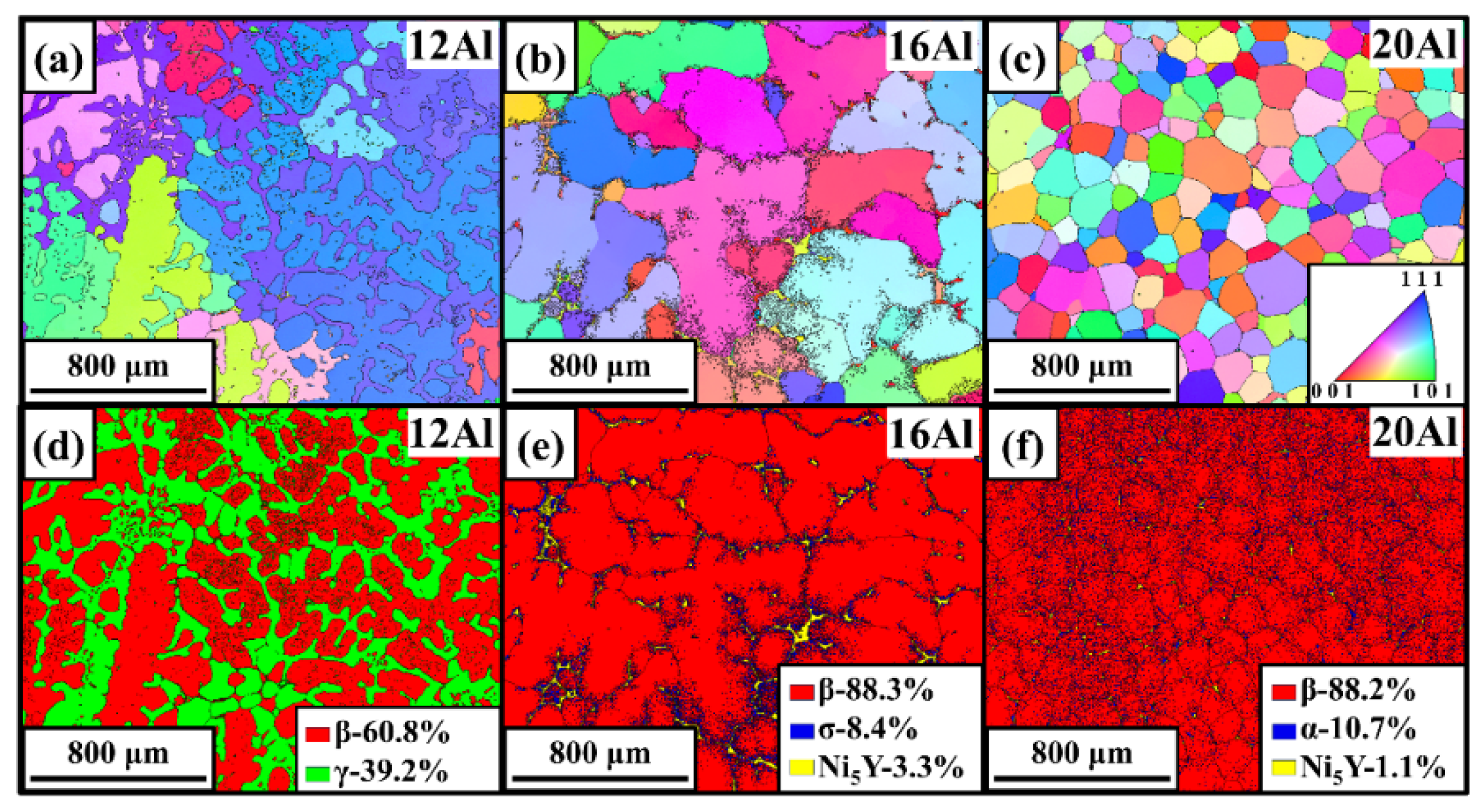
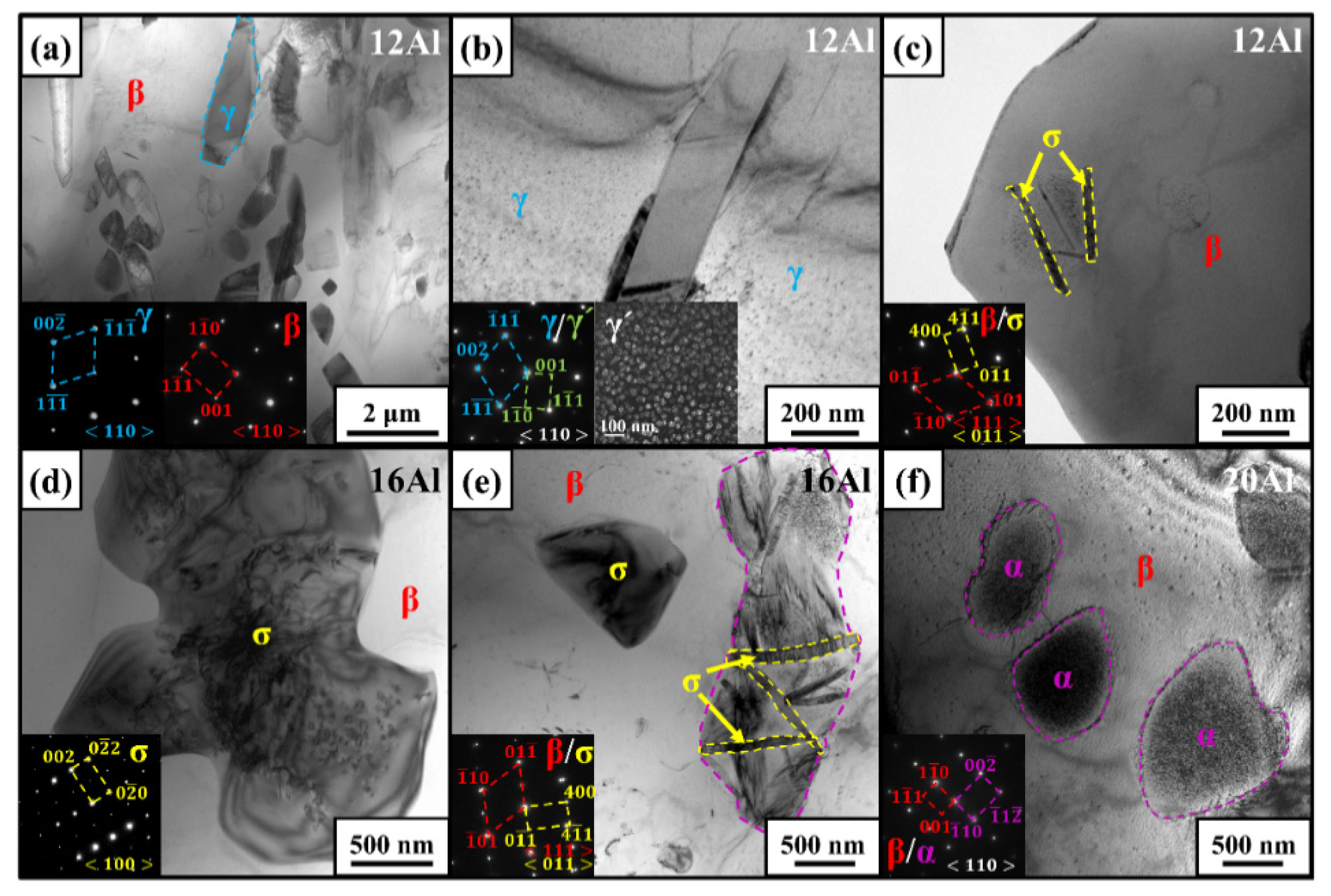
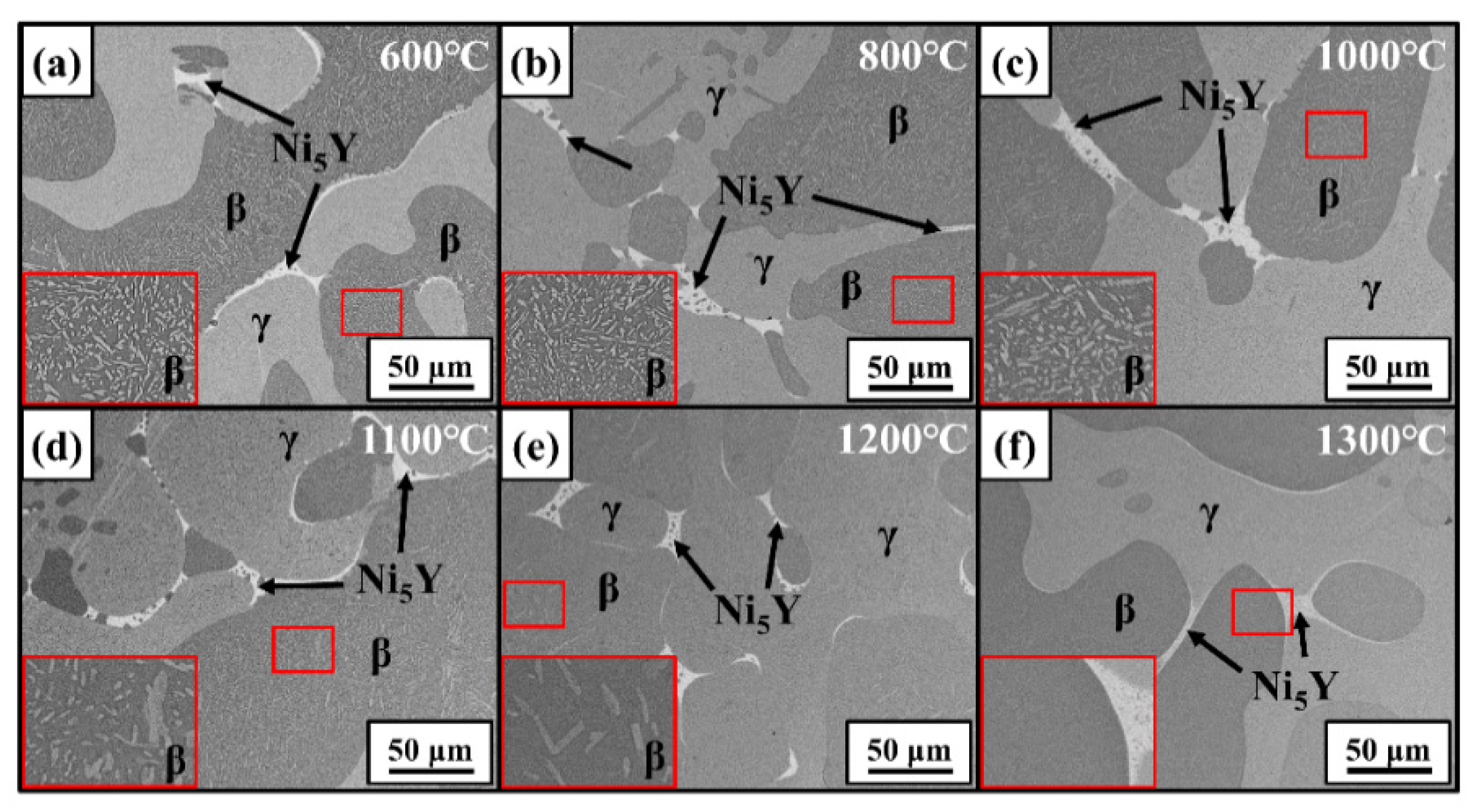
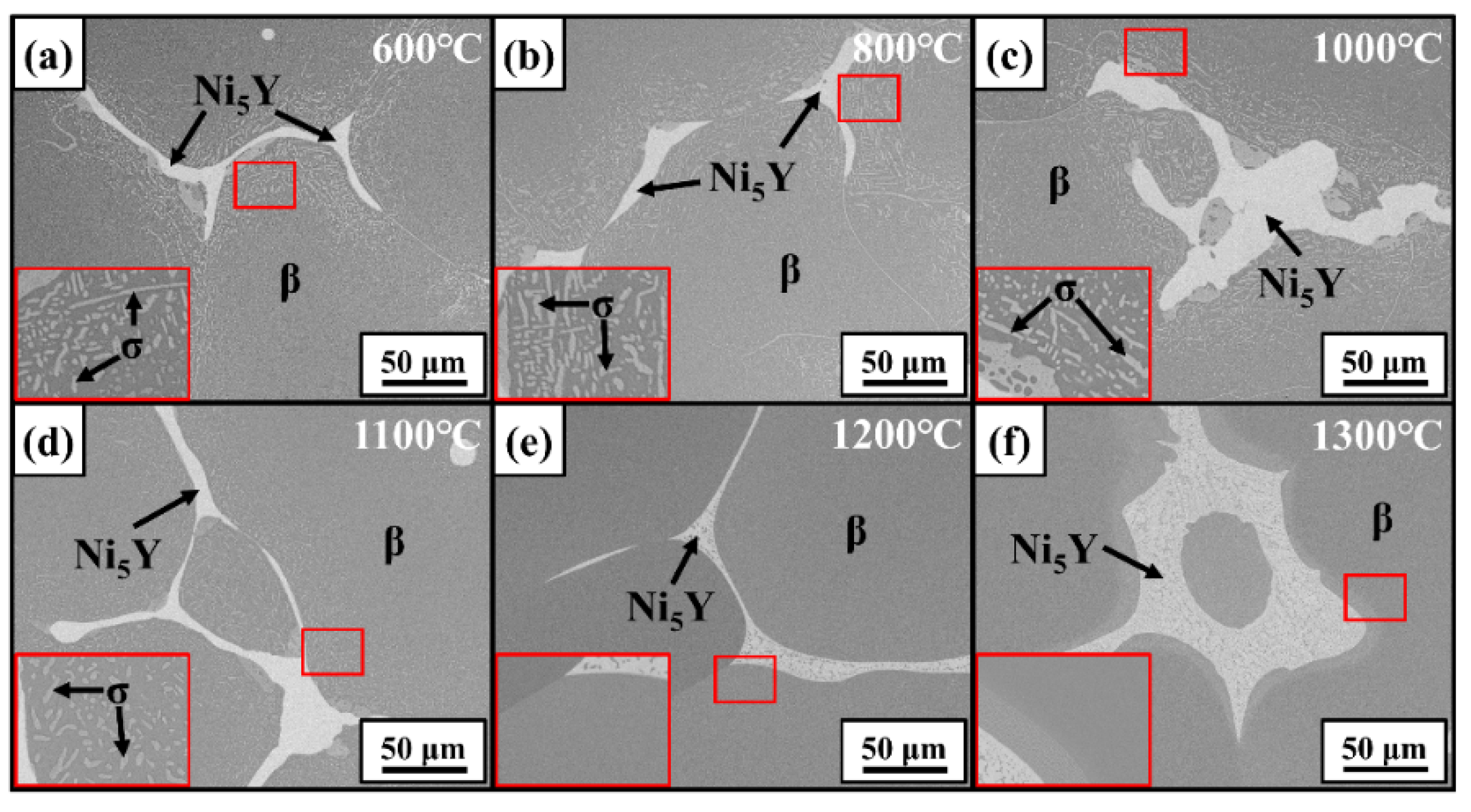
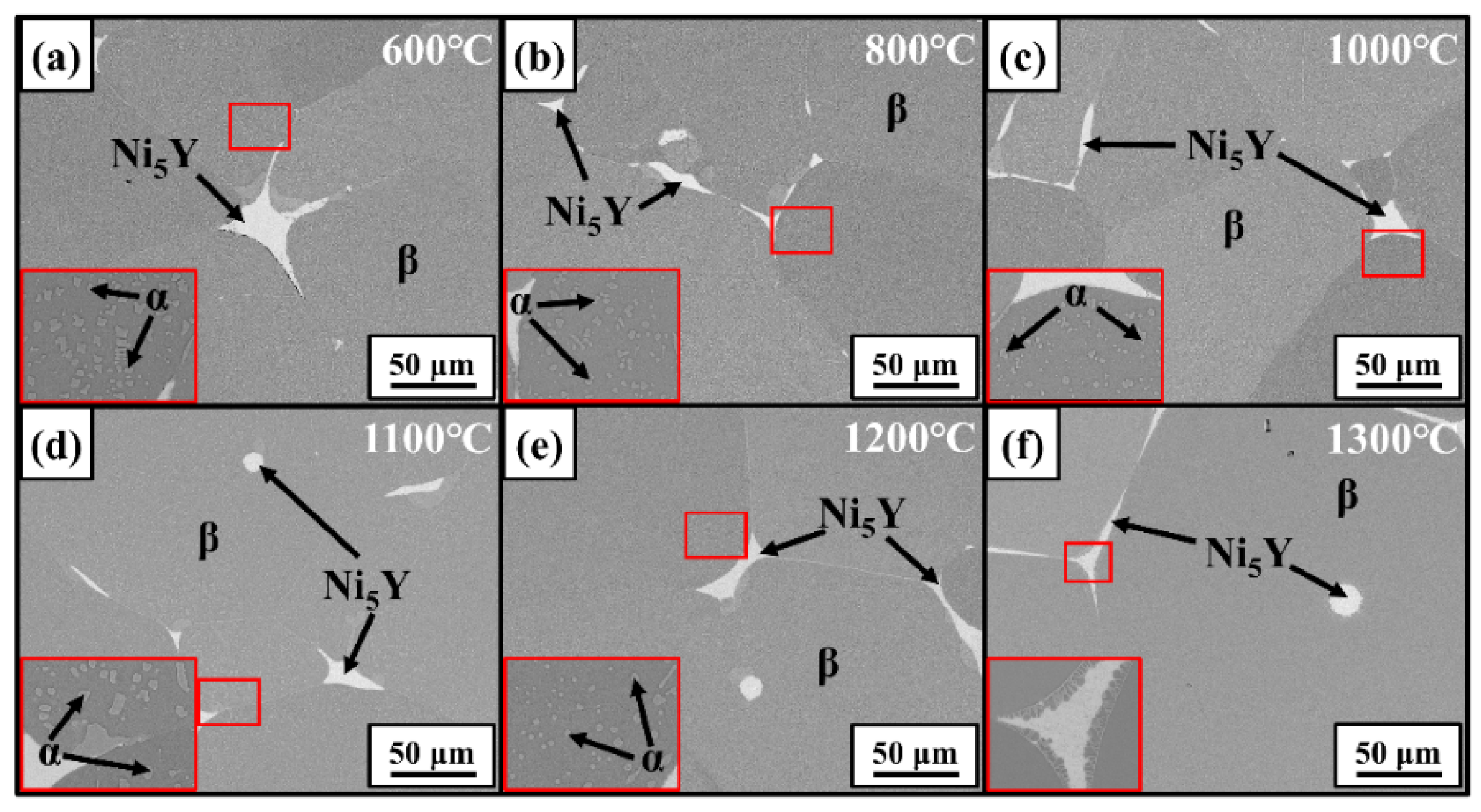
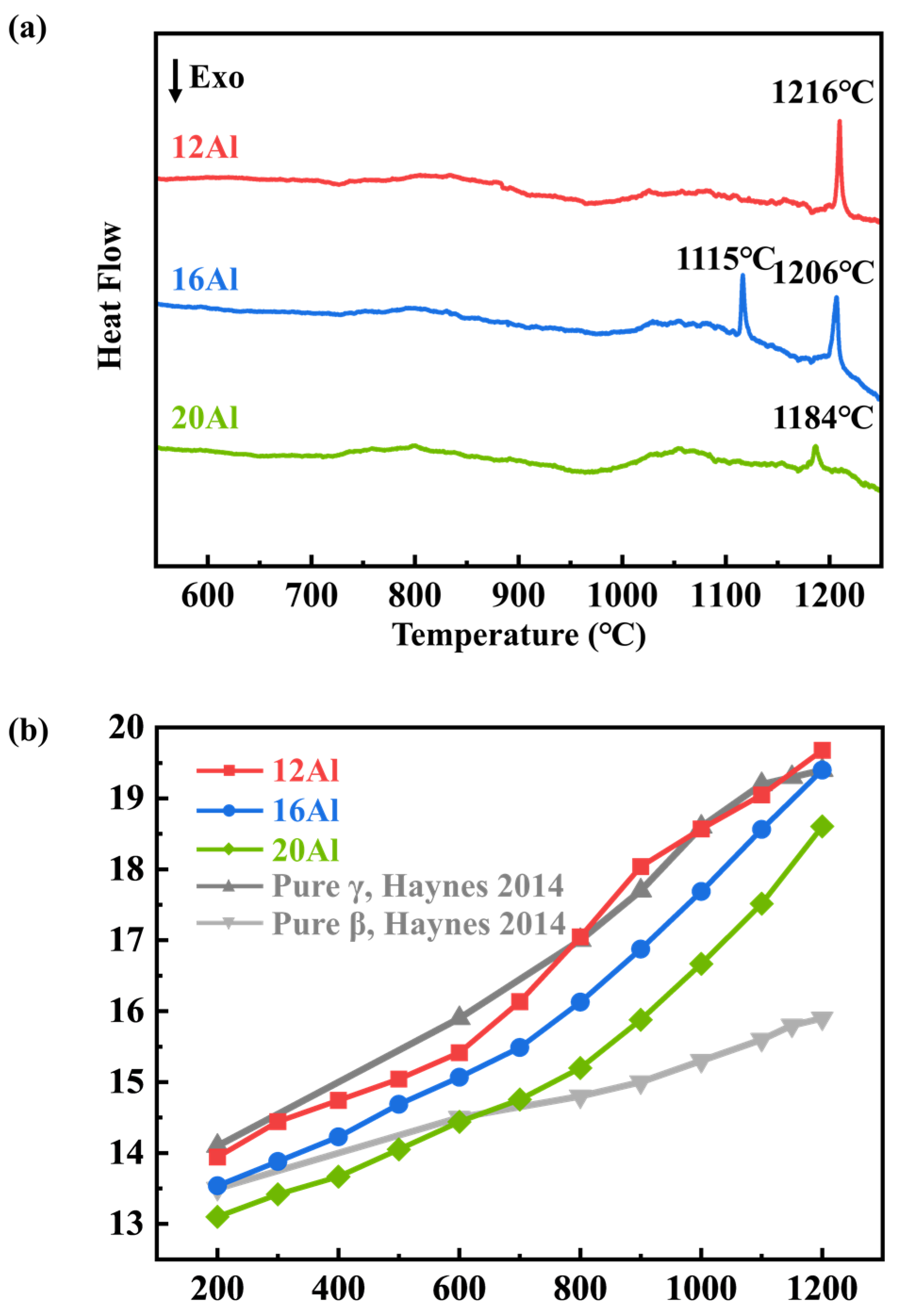
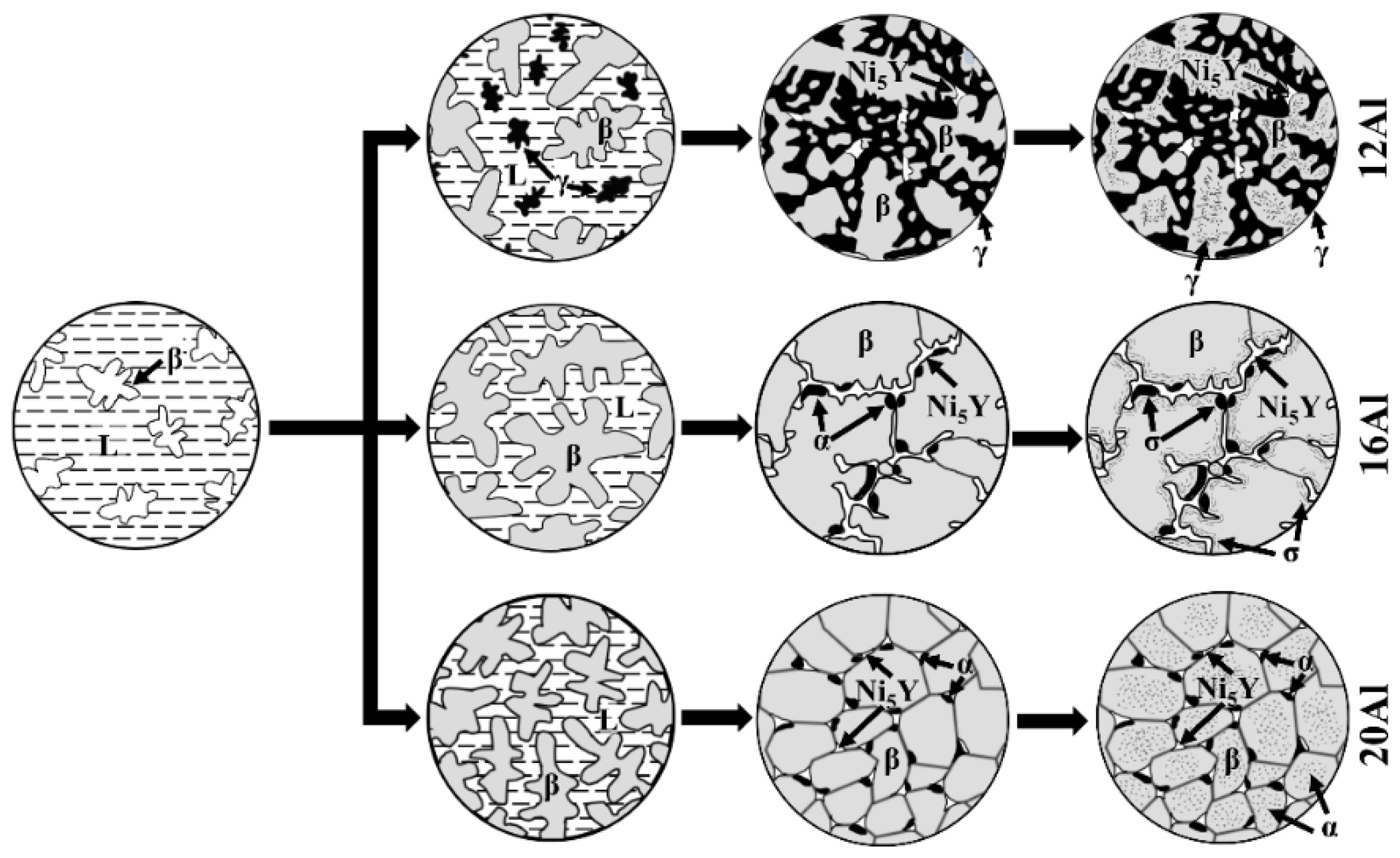
| Ni | Co | Cr | Al | Y | |
|---|---|---|---|---|---|
| 12Al | Bal. | 27.5 | 16.84 | 11.46 | 0.27 |
| 16Al | Bal. | 27.28 | 16.99 | 16.55 | 0.58 |
| 20Al | Bal. | 27.46 | 17.58 | 21.22 | 0.24 |
| Phase Name | Strukturbericht Symbol | Pearson Symbol Prototype Space Group | Thermodynamic Model |
|---|---|---|---|
| Liquid | - | - | (Ni, Co, Cr, Al, Y)1 |
| γ-Ni | A1 | cF4–Cu | (Ni, Co, Cr, Al, Y)1(VA)1 |
| α-Cr | A2 | cI2–W | (Ni, Co, Cr, Al, Y, VA)1(VA)3 |
| γ′-Ni3Al | L12 | cP4–Cu3Au | (Ni, Co, Cr, Al, Y)0.75(Ni, Co, Cr, Al, Y)0.25(VA)1 |
| β-(Ni, Co)Al | B2 | cP2–CsCl | (Ni, Co, Cr, Al, Y, VA)0.5(Ni, Co, Cr, Al, Y, VA)0.5(VA)3 |
| σ-(Co, Cr) | D8b | tP30–CrFe | (Ni, Co, Cr, Al)10(Ni, Co, Cr, Al)4(Ni, Co, Cr, Al)16 |
| Ni5Y | D2d | hP6–CaCu5 | (Ni, Al)5(Y)1 |
| Ni | Co | Cr | Al | Y | ||
|---|---|---|---|---|---|---|
| 12Al | β | 47.8 ± 1.1 | 25.0 ± 1.0 | 11.5 ± 1.0 | 15.7 ± 0.8 | - |
| γ | 37.6 ± 0.2 | 33.9 ± 0.3 | 22.5 ± 0.4 | 6.0 ± 0.2 | - | |
| Ni5Y | 51.7 ± 1.1 | 19.2 ± 0.4 | 5.3 ± 0.3 | 5.8 ± 0.5 | 17.9 ± 1.1 | |
| 16Al | β | 41.4 ± 0.7 | 27.6 ± 0.4 | 13.2 ± 1.0 | 17.7 ± 1.0 | - |
| σ | 12.7 ± 0.4 | 34.9 ± 0.3 | 49.9 ± 0.3 | 2.6 ± 0.2 | - | |
| Ni5Y | 42.1 ± 0.7 | 25.1 ± 0.4 | 8.1 ± 0.3 | 6.6 ± 0.2 | 18.1 ± 0.6 | |
| 20Al | β | 35.2 ± 0.4 | 29.9 ± 1.0 | 13.3 ± 1.9 | 21.5 ± 1.2 | - |
| α | 5.7 ± 0.9 | 22.9 ± 0.3 | 69.3 ± 1.1 | 2.1 ± 0.5 | - | |
| Ni5Y | 41.0 ± 0.4 | 21.7 ± 0.7 | 5.9 ± 0.8 | 8.1 ± 0.2 | 23.4 ± 0.3 |
| Ni | Co | Cr | Al | Y | |
|---|---|---|---|---|---|
| Ni | - | 0 | −7 | −22 | −31 |
| Co | 0 | - | −4 | −19 | −22 |
| Cr | −7 | −4 | - | −10 | 11 |
| Al | −22 | −19 | −10 | - | −38 |
| Y | −31 | −22 | 11 | −38 | - |
Disclaimer/Publisher’s Note: The statements, opinions and data contained in all publications are solely those of the individual author(s) and contributor(s) and not of MDPI and/or the editor(s). MDPI and/or the editor(s) disclaim responsibility for any injury to people or property resulting from any ideas, methods, instructions or products referred to in the content. |
© 2024 by the authors. Licensee MDPI, Basel, Switzerland. This article is an open access article distributed under the terms and conditions of the Creative Commons Attribution (CC BY) license (https://creativecommons.org/licenses/by/4.0/).
Share and Cite
Zhang, J.; Nie, Z.; Tan, C.; Mu, R.; Li, S.; Ning, X.; Tan, C. Effects of High Al Content on the Phase Constituents and Thermal Properties in NiCoCrAlY Alloys. Materials 2024, 17, 3025. https://doi.org/10.3390/ma17123025
Zhang J, Nie Z, Tan C, Mu R, Li S, Ning X, Tan C. Effects of High Al Content on the Phase Constituents and Thermal Properties in NiCoCrAlY Alloys. Materials. 2024; 17(12):3025. https://doi.org/10.3390/ma17123025
Chicago/Turabian StyleZhang, Jin, Zhihua Nie, Chengpeng Tan, Rende Mu, Shilei Li, Xianjin Ning, and Chengwen Tan. 2024. "Effects of High Al Content on the Phase Constituents and Thermal Properties in NiCoCrAlY Alloys" Materials 17, no. 12: 3025. https://doi.org/10.3390/ma17123025





